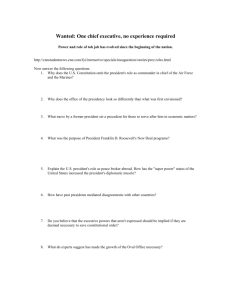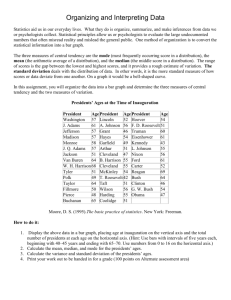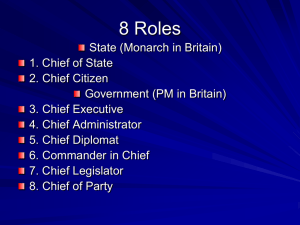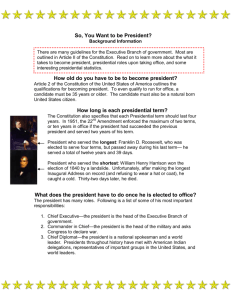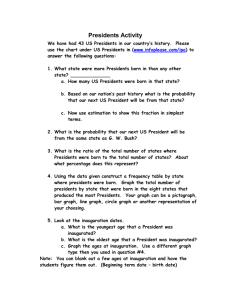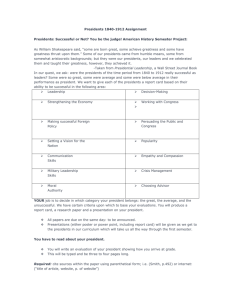Presidents and Public Opinion
advertisement
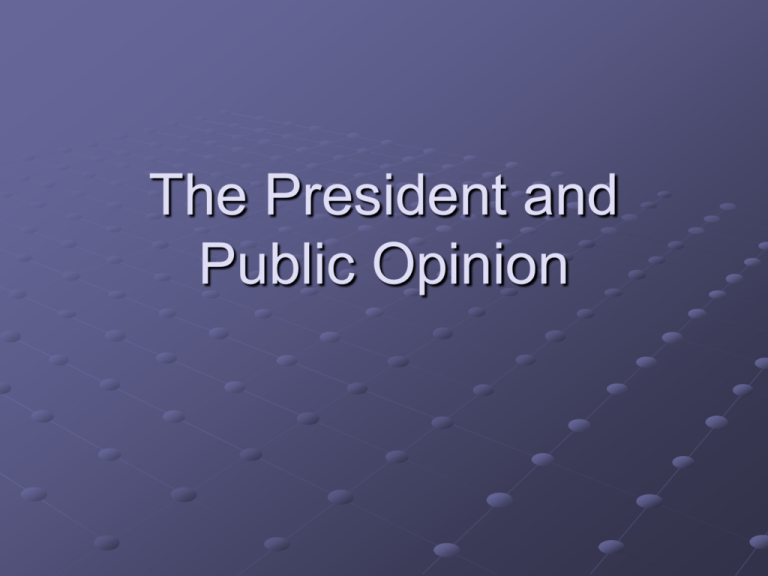
The President and Public Opinion Representation, Power, and Public Opinion From the standpoint of democratic theory, the president is the only elected official in the U.S. who represents the public at large. Congress viewed in macro does, but individual members do not, except in the sense that they have a duty as public persons. The Supreme Court represents the law. Accordingly, the president should reflect some overarching sense of public preferences. Which public preferences? The public at large? The electoral coalition? These are important questions in democratic theory. Presidents also care about public opinion because of power concerns. Public sentiment is very important to the president. A principal source of influence for presidents is the approval they receive from those in the policy environment. This includes the public at large, a policy community of elites, as well as fellow partisans. The president wants to please the public, or at least avoid irritating it. Presidents also want to lead the public. Moreover, presidents are expected to be leaders. There is a reciprocal relationship here. Presidents want to both please and lead the public. Impediments to Leading Public Opinion Gauging public opinion is a difficult task. The public may not have clear views on many issues The public is often ill informed The public is volatile, often being set off at symbolic issues Polls may be inaccurate, biased by methodology. Public sentiment can be soft. People around the president may tell the chief executive what he wants to hear, rather than what they need to hear. Nixon surrounded himself with loyalists, rather than professionals. George W. Bush also to a great extent. The president is in the limelight of American politics, with the media focusing in on every little detail. The media is very important to public opinion. The media may not provide the sort of favorable treatment that the president wants. As a result, presidents may lose control of their message and public opinion. The public has extremely high expectations of the president. Personally their lives are expected to be conducted at a much higher level than almost any individual citizen. They are also expected to be “all intelligent”, prescient, exhibiting strong personality, effective leadership skills, decisive, effective in public speaking, hard negotiators. It is not clear that any individual can meet up to the public’s expectations. Thus, there is a substantial gap between the presidential reality and the public’s expectations. This is often called the “expectations gap.” Part of the reason for the public’s high expectations of the president lies in its lack of understanding of the context in which the presidency operates. He is assumed all powerful; yet the presidency is probably our weakest institution in terms of formal powers and ability to exercise power. Presidents must often persuade. Contradictory expectations of the president: Leader, an independent figure who speaks out and takes stands on issues. Responsive to the electorate and mass public. A no win situation. If they are too independent they can’t be responsive; if too responsive they are considered to be “wafflers.” Clinton perceived as a “waffler” early on as he was more responsive. Flexible and willing to compromise on issues; decisive and taking a firm stand reflecting strong values and well reasoned positions. A statesman who places the “nation’s” interests ahead of “particularistic” interests. A skilled politician who can build coalitions and get things done. Open administrations with a free flow of ideas, and keeping the details of government visible to the public. No secrecy. President should be in control of things. Evidence of internal dissent is seen as that the president in not in charge. We want our president to “keep us safe”! Yet, we also want our president to respect civil liberties. Are the two things compatible? Can the president keep us safe without conducting surveillance operations directed at those who would make us unsafe? Who decides who these are? Populist tendency to relate to the average person is desirable. Yet citizens do not really want the president to be like them, since he is held to a much higher standard. Average citizen has lied, stolen, been unfaithful maritally, been divorced, seen a shrink at one time or another, been drunk, sampled illegal drugs, etc. Great presidents are not passive followers of public opinion; they are leaders of it. Teddy Roosevelt. “People used to say of me that I ... divined what people were going to think. I did not ‘divine’. I simply made up my mind what they ought to think, and then did my best to get them to think it.” Presidents can offer several rationales for not following public sentiment. Nixon and Vietnam and the “silent majority.” Doing what’s “right”, rather than what’s “popular.” Johnson and civil rights, the poor. Presidential goals are often to “move” public opinion. However, reasonableness suggests that they cannot move it too far. Moving public opinion provides a quintessential test of a president’s ability to lead. George Edwards book “On Deaf Ears” makes a convincing case that presidents cannot systematically move public opinion. Yet, there are critical examples through history where presidents did move public opinion. Washington and the Jay Treaty, Adams and the quasi-war with France. Roosevelt and the New Deal. George W. Bush and the Iraq Invasion. Presidents who lead, move public opinion to their perspective. Presidents who facilitate simply channel already existing public opinion into policy initiatives. Understanding Public Opinion In order to effectively use public opinion to their advantage, presidents have to know what public sentiment is. Citizens don’t have crystallized and coherent views on most issues. Moreover, on the details of policy they haven’t the foggiest. It requires great effort to become informed on the issues. Citizens lack the time, expertise, and inclination to do so. Citizens have preferences only over the general contours of issues and governmental activities. A mean and a variance exists for specific issues; however, citizen preferences also involve aggregations of issues. People operate more at the symbolic level than a rational level on issues and policy. Question wording matters. Want a balanced budget; want all of the programs currently in the federal budget. Want lower taxes; want no reduction in government programs. Want an end to “big government”; want all of the benefits that government currently offers, and more. Hate “bureaucracy”; if ask those who have dealt with the U.S. federal bureaucracy about the quality of their relations they overwhelmingly approve of interactions with bureaucracy. James A. Stimson claims that citizens have only a nebulous sense of liberalism/ conservatism on the issues. Collective public opinion has different properties than the opinions at any one time of the collectivity. Changes occur at the margins. Measuring Public Opinion Opinion Polls-A common tool for studying and understanding public opinion is opinion polls. Gallup, Harris, Roper, CBS-New York Times, etc. Presidents since Roosevelt have used pollsters. Presidents don’t typically have exclusive use of pollsters; too expensive; do hire outside firms and pollsters. Roper Center http://www.ropercenter.uconn.edu/data_access/ip oll/ipoll.html Polls have their problems. Public opinion is nebulous and volatile on some issues. When citizens don’t have strong views it is possible to get a lot of variability in responses. Polls don’t always measure what the president needs to know. Agree/disagree, yes/no questions tell little about the details of policy and the nuances of issues. Responses may reflect the particular wording of questions. If you ask about “welfare” you are likely to get a different response than if you ask about the “poor, homeless, and needy”. Citizens are overwhelmingly opposed to “welfare”, but also overwhelmingly “humanitarian” in their desire to help the poor and homeless. Polls are not taken in a timely fashion and when presidents need them when taken by independent polling organizations. Yet public opinion is dynamic. Election Results Presidents often attempt to claim a mandate based on the presidential election. Yet elections are aggregations of preferences and do not constitute mandates on particular issues. Problems with using election results: Voters may approve of candidates, but not have opinions on particular issues or policies. Symbols are more important in elections, as well as party id. Voters often do not know candidate’s stands on the issues. Candidates have an incentive to not be clear on the issues and policies they support. Downsian model. The election reflects the views of only part of the electorate; those who turned out; those who voted for the candidate. Does the elected have the obligation to represent all or only the winning coalition. The president may not know what the public’s views are, even after an election. What does the election mean? Reagan in 1980 claimed that citizens were favorable to the message of reducing “big government” and “getting the government off the backs of states and citizens”. However, they were not favorable toward reducing environmental protection, equal employment opportunity, consumer protection, anti-trust regulation, etc.? In other words, election outcomes do not produce a clear message for the president. Reagan was unsuccessful in both reducing the size of government and diminishing government regulation. Election results are a rather tenuous way to gauge public opinion. Mail from the Public-The White House receives several million pieces of mail annually, including email. All are answered by someone. The White House staff typically will prepare a synopsis of public views for the president. Is the mail a random sample? Skewed toward activists; those who have intense feelings on the issues. http://www.whitehouse.gov/contact/submit-questionsand-comments Presidents have a lot of trouble understanding public opinion. Even if they could understand public approval it is not clear what it means. It is extremely volatile. Public Approval of Presidential Job Performance Presidents seek a favorable job approval rating from the public. Job approval translates into power along various dimensions, including in Congress and with regard to controlling the general agenda of the media and Congress. It generates respect for presidential leadership. Aggregate approval of the president’s job approval is dynamic. For this reason it may not be very useful to simply look at averages over an entire term. However, here is a table from the Gallup site reporting averages for each president since Truman. http://www.gallup.com/poll/116677/presidential-approvalratings-gallup-historical-statistics-trends.aspx Five presidents since WWII have averaged approval less than 50 percent over their entire terms, Truman, Nixon, Ford, Carter, and George W. Bush. However, this set of averages can be misleading since there can be substantial variations on a month to month basis. The averages hide substantial variation within presidencies that are significant to understanding the president’s job approval. Here are graphs of presidential job approval since World War II. Gallup, Roper Center Approval • http://www.gallup.com/poll/124922/Preside ntial-Approval-Center.aspx • http://webapps.ropercenter.uconn.edu/CFI DE/roper/presidential/webroot/presidential _rating.cfm • http://www.presidency.ucsb.edu/data/popu larity.php?pres=&sort=time&direct=DESC &Submit=DISPLAY#axzz2j8pOtHsV How do people arrive at their evaluations of the president? Party identification. Research shows that there is a partisan basis for public approval of the president. Democrats overwhelmingly approve of a Democratic president; Republicans overwhelmingly approve of Republican presidents. Polarization along party lines in approval/disapproval. The public was especially polarized along party lines during the Reagan administration. On average the polarization has been about 40 percent; during Reagan it was about 52 percent. Now it is even higher. Independents represent a group that increase the variability in approval for the president. Independents tend to be less polarized in approval/disapproval for the president running about 20 percent from both Democrats and Republicans. Positivity bias-Presidents are almost always evaluated positively at the beginning of their terms. Citizens give them the benefit fo the doubt. Moreover, approval tends to go up substantially between the time of the election and over the first few months. Show graph again here. Comparison of Electoral Percentages and First Post-Inaugural Approval President Eisenhower Kennedy Johnson Nixon Carter Reagan Bush I Clinton Bush II Obama Source: Gallup Polls Popular Vote in First Election % 55 Approval in First PostInaugural Poll % 69 50 61 72 71 43 50 51 60 66 51 53 43 48 51 58 60 53 68 Persistence of approval-Honeymoon period in approval ratings is variable with the presidency. Long term decline in approval During each presidency there is a tendency toward decline, There is also a longer term decline across presidents. Trust in government after Vietnam, Watergate. There is a relatively constant factor for most presidents that explains the mean level of approval. Things like personality, style, perceived ability, etc. enter into this. However, these things are not dynamic. Compare Kennedy to Nixon for example. The Economy- Clinton’s mantra was “It’s the economy, stupid!” The state of the nation’s economy is the single most important factor driving presidential job approval. Presidents are held accountable for the economy, regardless of whether they inherited a good or bad one. Rally events- Dramatic events affect the largest dynamic in presidential approval. Things like the Oklahoma City Bombing, the Persian Gulf War, the bombing of the U.S. embassy in Lebanon, the assassination attempt on Reagan in 1981, the invasion of Grenada, the negative images flowing from Somalia, September 11th, the invasion of Iraq. Scandal may affect approval. However, it may not always affect it in the logical direction. Watergate and Iran-Contra depressed the approval respectively of Nixon and Reagan. In contrast, Lewinsky-gate either increased or had no effect on Clinton’s approval. Presidential honesty, integrity, intellect, leadership capability. These are all dynamic and may enter into the way the public perceives the president. Nixon and Watergate. Carter was perceived as a weak leader when he had no ready solution to the Iran Hostage crisis. Bush I was perceived as vacillating when he went back on his pledge of “no new taxes.” Whitewater and media coverage of various other issues hurt perceptions of Clinton along this dimension. Bush II was generally perceived as dishonest in the reasons for invading Iraq. Obama has been perceived as a weak leader, probably due to his inability to get things relating to the economy approved in a partisan Congress. Issues may affect approval. For an issue to affect approval it must be Salience- The issue must be important to large numbers of people. Economy, environment, foreign policy events. Valence-Within issue areas, bad news may outweigh good news in capturing the public’s attention. Bad news about the economy has more impact than good news. Responsiblity- people need to see the president as responsible for the issue for it to affect approval. Presidential performance on the issue must be seen as responsible. Summary: Public approval of the president may be a result of many factors. However, quantitative scholars do a fair job of explaining the aggregate series that we showed earlier using only two variables, economic performance and rally events.


